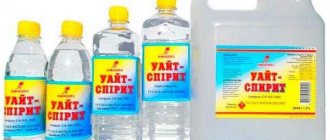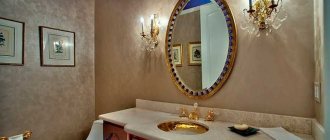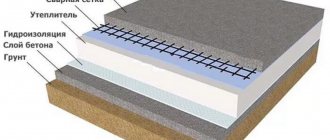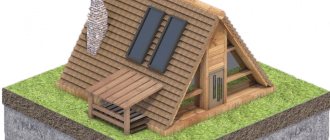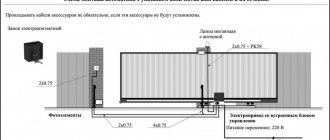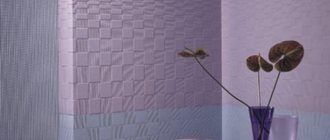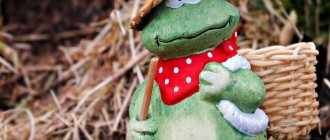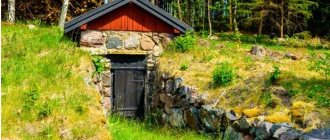Home » Building a house » Building materials
Construction Materials
Annie Cooper 04/30/2020
33875 Views 1 comment
SavingSavedRemoved 6
Oriented strand boards are often used for exterior decoration of building facades and interior work. Their characteristic, rough structure does not always correspond to the style of the room or the wishes of the home owner, so the surface is covered with paints and varnishes. Tips on what and how to paint OSB, and how to properly prepare the material for coating are collected in the material.
Material characteristics
Surface of particle boards
OSB (OSB) or oriented strand board is a sheet building material made from woodworking products (most often flat softwood chips) glued together in 3-4 layers.
The material is formed by hot pressing. The binding element is waterproof phenol-formaldehyde resin with the addition of synthetic wax and boric acid.
The name OSB is a transliteration of the English name OSB - oriented strand board.
The entire slab has a thickness of up to 3.8 cm and a length of up to 2.5 m. For production, chips of a strictly defined size are used: from 0.6 to 4 cm in width and 18 cm in length. The order of the layers in the sheet also matters: the inner ones are laid transversely, and the outer ones - lengthwise.
This structure gives the material the properties of a plywood sheet:
- increases rigidity
- prevents deformation during installation
- increases resistance to mechanical damage
Application of OSB panels
OSB is used as rough flooring (under laminate, carpet, linoleum) or wall material for construction:
- temporary structures
- frames
- small architectural forms
- converting an attic into a living room
The material is also used as a raw material for the production of sandwich panels, I-beams, as a flooring for bitumen shingles on roofs and load-bearing structures of panel formwork.
OSB competes with bakelite and regular plywood as a structural material, and fiberboard, chipboard and plasterboard as a finishing material.
Coloring Tips
- When painting slabs with a roller, right-handers should apply the composition starting from the left corner of the room, and left-handers should apply it from the right. First, a line is made along the entire height of the surface, the second strip is drawn from the bottom up, shifted to the side by 15 cm. Then the angle changes, and the roller must be moved downwards. The roller movement should resemble the Latin letter W.
- To achieve a smooth surface, you need to apply the paint in a few words. Depending on the method of painting the slabs and the selected paint, 2 to 3 paintings may be required.
- When applying several layers, you need to wait for each layer to dry completely.
- The edges of OSB and joints need to be painted more carefully and carefully, since they absorb much more dye.
- If transparent paints are used, you need to choose formulations with inhibitors.
- To refresh the facade, 6 years after painting it, you need to reapply the paint. To make application comfortable, the composition can be diluted to a liquid consistency.
Advantages and disadvantages
Pressed chip sheets
Oriented strand boards are superior to other building materials made from wood products in some performance characteristics:
PROS:
- Show higher fire resistance than fiberboard, chipboard, non-flammability
- They do not have defects in the material structure (delaminations, air voids, knots) unlike solid wood
- Less time-consuming compared to other types of finishing
- Provide high heat and sound insulation
- Cost less than other wood chip materials
- Externally they differ little from wood
- Not affected by wood-boring insects
- Easy to process (drill, cut, glue and paint)
- Lighter than cement bonded particle boards/
MINUSES:
- However, OSB does not provide vapor permeability.
- When heated, it can release harmful substances (due to the phenolic-formaldehyde resin in the composition).
- When used in interior decoration, sheets must be painted or covered with other decorative material.
Methods for finishing OSB facades
OSB boards, which are made by pressing wood chips, are not the easiest material for facade finishing. The chips in the two outer layers of the board are perpendicular to the chips in the inner layer, and although all layers are impregnated with glue, OSB is considered a material that is not resistant to weathering and ultraviolet radiation.
But, despite the fact that the debate on the topic “is it possible to make external cladding of a house from OSB” still does not cease, many FORUMHOUSE participants believe that “this game is worth the candle”: in terms of speed, ease of installation, and especially - low cost of such a facade.
And, as practice has shown, if moisture-resistant OSB-3 (or OSB-4) is used for facade work, then all the horror stories about “swelling” are completely refuted by time. Under one condition - that such a facade will be closed (“protected”) from the effects of external unfavorable conditions as quickly as possible.
BirdofpreyForumHouse Member
If you want to throw away money, then you can use OSB as a finish, and a complete one at that.
OSB is a moisture-resistant material, that is, it tolerates high air humidity without changing its physical and mechanical properties. But, like any material made from untreated wood, it absorbs water when directly exposed. Such a facade should be closed in the very near future, says our expert, head of the SOPPKA project, Artem Vladimirovich Solovyov.
Artem Vladimirovich SolovyovHead of the SOPPKA project
Having extensive experience, high-quality feedback from our clients, as well as recommendations from OSB manufacturing plants, we can say with confidence that leaving the slab outdoors for more than 1-2 months will have the most negative impact on it.
How long a slab can remain outdoors without protection or finishing without losing its performance depends on weather conditions, but with regular interaction with water it will inevitably change its physical and mechanical properties. Also, the slab is exposed to ultraviolet radiation; under the sun it darkens, the binding resins burn out, and the top layer of wood chips begins to peel off.
Soloviev Artem Vladimirovich
We do not recommend leaving OSB unprotected over the winter. If the stove has been used in atmospheric conditions for more than a year, it must be restored because:
- the destruction of the top layer of the slab began;
- The stove, due to moisture, may be affected by fungus.
OSB consists of 90% wood, so for finishing the facade made of OSB or SIP panels, you can use the same materials as for wooden house construction.
The most popular finishing options for such facades include:
- siding;
- fake diamond;
- clinker tiles;
- ceramic tiles imitating brick;
- decorative plaster;
- painting.
Types of slabs
Laminated Chip Board
There are 4 types of slabs depending on their resistance to moisture and mechanical stress.
| View | Characteristic | Application area |
| OSB-1 | Low resistance to moisture, shock, deformation | Manufacturing of furniture, used as packaging material, upholstery |
| OSB-2 | High strength but unable to withstand moisture | For the manufacture of load-bearing structures, floors, only in dry rooms |
| OSB-3 | High resistance to damage and moisture | For the production of load-bearing beams and structures in any premises |
| OSB-4 | The highest levels of moisture resistance and strength | Can be used for any premises and purposes |
For finishing, the preferred choice is oriented strand sheets of types 2 and 3.
Depending on the outer covering, sheet material can be:
- Varnished
- Laminated
- tongue and groove
The elements are distinguished according to the finishing method:
- with straight edges
- milled (to simplify installation) on both sides
- milled on four sides
Slab preparation and painting technology
Correctly carried out preparatory work is the key to a good result.
Indoor painting work can be divided into 4 main stages:
- Leveling the surface. Produced by grinding. Sanding allows you to smooth the surface of the slab and make it unrecognizable. The most convenient tool is to use a grinder with a grinding wheel. You don't have to use a lot of force, just a light touch is enough. Particular care must be taken to sand the surface of OSB-3 and OSB-4 boards in order to remove the protective wax coating, which prevents the primer from penetrating into the structure and reduces adhesion to the paint and varnish composition;
- Sealing joints. It is best to fill the seams between the plates and the places where screws are attached with an elastic putty compound. If there is a need to create the effect of a monolithic surface and disguise the joints in the color of the slabs, add sawdust remaining after trimming the sheets to the putty. If after drying you see that the composition has come out beyond the seams, the surface can be sanded. If you need to make a perfectly smooth surface for a single-color painting, the seams can be taped with a special airtight “Rapid Cell” tape;
- Padding. Once you remove the top layer of material, the internal pores will open. OSB board shavings are combined using various resins, waxes and paraffins, which prevent the process of rotting. These substances must remain inside the structure. To “seal” the pores, special barrier primers are used, for example FI M194, which must be applied from a sprayer. The soil must be allowed to dry completely;
- Application of coloring composition. If we are talking about painting the facade, then after the priming stage it is necessary to fix the fiberglass mesh along the entire perimeter, fill the surface with a moisture-resistant and frost-resistant composition, and only after it has dried, start applying paint. It is recommended to carry out work in dry, windless weather.
Manufacturers and prices
Finishing building materials
The most widely used chipboards on the market are those produced in Germany, Romania, Canada and Russia. The main brands with prices per 1 sheet are presented in the table:
| Brand name | Manufacturer country | Price for 1 sheet |
| Glunz | Germany | from 1200 rub. |
| Arbek | Canada | from 800 rub. |
| Norbord | Canada | from 1000 rub. |
| Egger | Romania | from 1000 rub. |
| Talion | Russia | from 500 rub. |
| Kronospan | Austria | from 550 rub. |
| Kalevala | Russia | from 600 rub. |
German sheets from Glünz are considered the highest quality (but also the most expensive); Canadian products have proven themselves well: Arbeck and Norbord. Among Russian-made building materials, OSB brands Kalevala and Talion are popular.
How to improve adhesion
When encountering uncontrollable processes along the way, good builders have the habit of understanding the reasons and systematically regulating these processes. A solution has also been found for the capricious façade slabs Oriented Strand Board (OSB). All you need to do is refine the surface, give it the desired roughness, prime it and fill the small depressions on the front side with putty. Then the adhesion to the paint will improve. Sometimes it is enough to simply sand the surface with coarse sandpaper if you are going to paint with alkyd compounds. But on facade slabs it is better to use water-dispersed acrylate or silicone paints - they allow air and steam to pass through better. Through such porous coatings, internal moisture easily leaves facade structures when heated.
Preparing for painting
Painting sheets of shavings
Before you begin to apply the coloring product to the material indoors, it is prepared. The adhesion of the paint and the durability of the structure depend on the quality of the preparation.
Prepare the already assembled elements in the following sequence:
- Sanding with sandpaper or a sanding machine to eliminate unevenness and mask the recognizable texture of OSB. OSB-3 and OSB-4 sheets are especially carefully sanded, where the wax (varnish) protective coating must be removed. By skipping this step, there is a risk of chips and large chips peeling off
- Blowing wood dust from seams after sanding
- Leveling in places of fastening with self-tapping screws using putty mixtures based on glue and oil, “liquid nails”
- Cleaning dried putty with fine sandpaper to obtain a smooth surface
- Treatment with specialized emulsions that give the material additional resistance to moisture, combustion, fungi, and mold
- Primer with a mixture of alkyd varnish with water or white spirit (in a ratio of 1 to 10). An adhesive primer is also suitable, which will not allow the essential oils in the structure of the slab to bleed through the light pigment. If OSB-3 and OSB-4 are primed, then choose compositions for applying decorative plaster or mosaic
- The perimeter of each element is painted with a brush in 3 layers, the internal space is worked with a roller in 1 layer in one direction.
- Allow the paint to dry completely and apply a second coat.
If the material is coated with water-dispersion compounds, then only 1 layer is placed over the entire surface of the slab - this way the slab will swell evenly.
Primer solution
It is more convenient and easier to treat OSB sheets with the recently popular acrylic varnish (a more durable version is acrylic-polyurethane). The base is diluted in a ratio of 1:10. Good results are achieved by using alkyd varnish, but it should be diluted with white spirit before use. Apply the composition carefully, slowly, so that it is better absorbed.
The second option is to use a special primer that increases paint adhesion. Such soils are called adhesive. They are ideal for light paint; in addition, they form a protective layer that prevents stains from the release of resin and oil contained in OSB from appearing on the surface.
How to choose a coloring composition
Choosing paint for wood board
To choose a paint for coating sheet particle material, it is recommended to pay attention to the following properties:
- protection from ultraviolet radiation, negative effects of the atmosphere (rain, snow accumulation), fire, rot, mold
- the presence of additives with fire-retardant and adhesion-increasing characteristics
- surface adhesion parameters
- number of layers (to calculate consumption per 1 m2)
It is also worth considering the age of the boards (the older the OSB, the worse it adheres to the surface) and their condition (before painting, the surface is cleaned of dirt, layers of old paint, and treated with antiseptics).
Criteria for choosing paint for interior work
Paint and varnish materials for surface treatment of OSB boards should be selected taking into account the following factors:
- purpose of the premises;
- type of surface (walls, floor, ceiling);
- the type of chip layer and binder used when pressing the boards.
Choice of paint.
When choosing a painting material, it is recommended to pay attention to the coefficient of adhesion to wood and the presence of additives. In addition, it is worth considering the number of layers for painting in order to calculate the total material consumption. This value can be calculated using the data indicated by the manufacturer on the packaging (paint consumption per 1 m² per 1 layer).
In addition, you should take into account the aesthetics of the finish depending on the type of interior - you can make the surface smooth or leave a relief structure.
Coloring materials are selected depending on the type of composition. For example, alkyd paints are suitable for painting any surface, creating a durable coating, but their consumption will exceed that of oil-based paint. Oil paints will have lower consumption and absorption coefficient, so they are recommended to be applied to floors.
Pay attention to: The second life of shoes: the nuances of painting yourself
Water-based and acrylic-based emulsions are a good material for finishing OSB ceiling boards in a children's room or bedroom, since they are environmentally friendly.
Polyurethane dyes are suitable for rooms with high humidity, such as bathrooms and kitchens. Coatings made from polymeric coloring materials are durable and wear-resistant.
If the interior involves the use of natural materials, then a coating of transparent water-based varnish will help preserve the natural appearance of the wood. In addition to aesthetics, this varnish will protect the surface from moisture and minor mechanical damage.
For rooms where OSB is installed as a finishing floor covering, a smooth floor with a water-repellent effect is required. For these purposes, a thick layer of transparent epoxy is applied to the chip surface; after hardening, this coating becomes dense, hard and waterproof.
To improve the appearance and preserve the natural structure of the panels, they can be covered with stain and then secured with vinyl varnish or glaze. It will emphasize the naturalness of the finish, highlighting the color of the wood.
You should pay attention to the age of the panels: the older the OSB boards, the worse the paint will adhere and more thorough surface preparation will be required.
Indoor painting methods
Particle boards in interior decoration
OSB is coated with paints and varnishes to:
- Additionally protect the material from moisture and reduce the risk of fire
- Disguise the texture of slabs during interior decoration and add decorativeness to them
- Save on cladding with plasterboard or MDF panels
Experts do not recommend covering building materials with water-dispersed acrylic compounds in several layers for exterior work - the slab may swell.
OSB wall panels
For interior work, particle boards cover:
- Oil paint - it has high viscosity and is not absorbed into the material. Provides a reliable, durable coating, but takes quite a long time to dry
- Alkyd paint or enamel. Penetrates deeply into the structure of the chips, so there is no need to varnish the material on top
- Stain. With this type of painting, the natural texture of the slab remains visible. The top of the building material is coated with polyurethane or vinyl varnish to secure it. The desired tone can be obtained by diluting the composition with water, acetone or solvent
- Glazing azure. Transparent thin paint allows the chips to retain their structure and only slightly shades the color
- Transparent varnish or impregnation to preserve the natural texture of the slabs
Technology of applying paints and varnishes
Difficulties begin at the preparatory stage. Before the entire area is varnished, it is carefully sanded. OSB-3 panel material is sanded on the front side, only the joints are processed. For this, an acrylic wood sealant is used. The treated seams are sanded. Only after this is the layer coating applied. Each subsequent layer is applied after the previous one has dried. The cladding of OSB boards ends with final polishing. Oil- or acrylic-based varnish does not cause the slabs to swell.
Important: the joints are not treated with silicone-based sealant. The dried material does not adhere to varnish.
Before varnishing, the edges of the panels are rounded and sharp edges are removed. Putty is used to treat the depressions that appear along the edges. After sanding them, the primer is applied to the entire surface. Paintwork is applied.
How to paint the panels outside
Painting slabs outside
For external finishing work - finishing the facade, installing partitions and floors - oriented strand boards are coated with impregnations, varnishes and paints:
- alkyd
- oil
- water-based
- acrylic
- latex
When choosing a material for painting, it is better to choose compositions that contain special additives that protect the slabs from exposure to UV radiation.
The coating must also be vapor permeable, otherwise mold will form on the slabs. An impermeable coating can cause warping of sheet building materials.
Alkyd paint
Alkyd paint
Alkyd paint Its composition includes plant resins, film formers (glyphthalic or pentaphthalic), pigments, purified kerosene, fillers and antiseptics. After coating and drying, a film remains on the surface of the material, which provides additional strength to the OSB.
Dries quickly, is non-toxic, creates a waterproof layer, protects against temperature changes. However, it has a pungent odor and is prone to fire.
If such a composition is applied to the slab before it dries completely, bubbles and peeling will form on the surface. This coating significantly reduces finishing costs, because the alkyd composition eliminates finishing impregnation with varnish.
Water-based mixture
Water-based paint
Water-based mixture The composition of the two-phase mixture includes water and acrylic, fillers, film formers, pigments and a number of functional additives. After drying, the water evaporates, and the polymer layer gives the slab improved performance characteristics.
In addition to such advantages of paint as quick drying, non-toxicity and lack of a strong odor, the advantages include:
- low price
- variety of colors
- high resistance to fire and moisture
- ease of application
- service life up to 10 years and above
External work is carried out at a temperature not lower than +5. In the cold the composition becomes unusable.
For finishing, water-dispersion relief paint with the addition of marble dust or fine chips is also used. Its cost is higher than that of traditional water-based paint, but due to the relief it produces a beautiful decorative look.
Latex composition
Latex composition
Latex composition A type of water-based paint, but instead of acrylic, the binder is a latex additive (based on vinyl, polyvinyl, silicone). The composition is elastic, viscous and durable, giving the surface characteristics of resistance to moisture, aggressive chemicals, UV radiation and temperature changes.
The paint is non-toxic and has no unpleasant odor. Using latex, you can get both a smooth and textured coating.
Acrylic based coating
Acrylic copolymer paints
Acrylic-based coating This raw material covers unevenness of the structure well and gives a uniform tone. It consists of polymers, water and dye, and after drying it leaves a durable film on the surface of the material. It can be matte or glossy; there are many colors in the assortment that do not require additional tinting.
The acrylic composition does not spread, does not fade, dries quickly, has the ability to allow steam to pass through, but is resistant to moisture. It is often used for interior work because it is non-toxic and does not emit harmful substances into the atmosphere when heated.
Oil paint
Oil paints
Oil paint Raw materials using drying oil are rarely used due to their high toxicity and long drying time.
The oil composition leaves a lot of streaks and unevenness, while the coating does not last long, quickly crumbling and peeling off from the surface.
Choosing paint for exterior work
You need to choose a paint that is resistant to UV radiation. Otherwise, the paint and varnish material will quickly delaminate under the influence of sunlight, and the walls will need to be painted again.
We recommend: Installation of an expansion tank in the heating system, connection and installation
For exterior work, it is better to choose polymer-based dyes that are suitable for coating wood surfaces. Such paints will reliably protect the surface from precipitation and the influence of ultraviolet radiation. They apply well and are used sparingly.
Before application, it is necessary to prepare the slab, level it, and then prime it. Large dents, holes, and OSB joints are best sealed with putty.
On the facade and external walls it is better to use oil, alkyd, acrylic, latex paints and others.
Oil paints. This type of dye is poorly absorbed into the surface and has good viscosity. It takes a long time to dry, but after drying it forms a dense protective layer with increased performance properties. Disadvantages: high cost, relatively short service life, long drying time, severe smudges. The dye mixture has a pungent odor and is toxic to humans, so it must be applied to a protective mask or respirator. To reduce the number of smudges, this dye needs to be applied 2-3 times. If you apply the coloring agent to a damp surface, it will quickly peel off. The drying time of the layer is at least 1 week.
Alkyd paints and enamels. Facade paint of this type penetrates deeply into the OSB, increasing its service life. After painting, the facade does not need to be varnished. This allows you to save on finishing. Alkyd dyes are low-toxic and dry quickly, but they can only be applied to a dried surface. Bubbles appear on wet slabs after applying enamel. After rain, the façade can be coated with alkyd paint no earlier than 2 weeks later. The composition is resistant to sunlight and low temperatures down to -35°C. After applying the mixture, the surface becomes flammable, since it contains flammable resins. To prevent accidental fire, a layer of fire-resistant emulsion must be applied over the alkyd paint.
Acrylic dyes. They easily smooth out roughness and paint the surface a uniform color. If the walls are primed with a composition that is not susceptible to mold, they can then be painted with waterproof façade acrylic paint. It is environmentally friendly, easy to apply, durable. Thanks to its water base, acrylic dye is highly resistant to fire, temperature changes, and UV radiation. The presence of water in the composition is a disadvantage, as it can cause swelling of the wood.
Latex water-based solution based on silicone, color, vinyl or polyvinyl. The material is environmentally friendly, elastic, resistant to mechanical damage, moisture, and household chemicals. Does not emit a pungent odor. Has a palette of colors. Apply with a sponge roller with large pores or a spray gun. The only drawback is the high price.
- Impregnations based on tall or linseed oil. They hide the natural texture of the slab and create a matte or slightly glossy protective film on its surface.
- Electrically conductive paint (conductive). Contains metal. Gives the coating greater strength and protects wooden slabs. Application requires complex preparation.
- Antipyretics. Protect wood boards from fire.
OSB walls are better protected from moisture penetration and exposure to UV radiation by polymer-based paints. Water-based compositions cope with this task worse. Surfaces coated with acrylic paints are easy to clean. But coatings made of alkyd resins and polyurethane reliably protect against mechanical influences.
Fire protection
Soppka paint and varnish material
In addition to making the slabs decorative, painting can also be aimed at improving the performance characteristics of OSB. When ignited, particle boards emit caustic phenolic smoke, which is dangerous to humans, so it is important to cover the material with fire-retardant solutions.
Soppka paint is produced specifically to increase the resistance of particle boards to fire. The composition also prevents the development of mold in poorly ventilated areas.
The paint is much more viscous and thick than conventional antiseptics, and creates a protective transparent film on the surface of the material. The mixture is evenly absorbed into the OSB, despite the presence of resins in it, and is not washed out by rain over time.
Non-specialized but high-quality façade glaze Valtti Color Satin from the manufacturer Tikkuril is also suitable for fire bioprotection. It has high hiding power, does not fade in the sun and prevents wood from rotting.
Decorating the outside of the house with OSB slabs
OSB boards are used for the construction of frame buildings or to cover wooden houses. They have good insulation and strength, although this material is not sufficiently moisture resistant. The raw material for the production of OSB is non-working coniferous wood or wood processing waste. OSB facades can be subject to deformation under the influence of water. However, it stands out due to its environmental friendliness, practicality, ease of processing and installation.
Construction experts advise using OSB-4 or OSB-3 boards for cladding the outside of a house, but the second option is considered less preferable. You can sheathe the outside of the house with OSB of the third group, but it does not have special protection from moisture, so it must be additionally processed. OSB-4 is significantly more expensive, so exterior finishing of a house using OSB boards is not done very often when constructing economical buildings.
Since the basis of OSB boards is pressed shavings, OSB can be treated for exterior finishing with any paint compositions that are suitable for wood material. Limitations are determined solely by aesthetic features. In particular, there is no need to choose transparent varnishes or glazes. The chip texture is not endowed with special beauty, so it does not need to be put on public display.
In addition to painting OSB boards, facade plaster is also suitable. The technology for plastering the facade is described in detail in the corresponding article; it will not have any special features if the base of the wet facade is an OSB slab. You can perform plastering with or without insulation. Pay attention to the primer, it increases the adhesion of the base, i.e. the plaster composition fits and attaches better. In this article we will talk in detail about how to paint smallpox on the facade.
The best paints for OSB
Toplazur
Paint and varnish materials that are best suited for painting OSB boards with their performance characteristics:
- Cetol Filter 7 Plus from Sikkens is a transparent paint for exterior use based on alkyd resins. The composition includes inhibitors and additives that enhance the moisture resistance of the material. Drying at 20 degrees Celsius and 65% humidity occurs in 15–16 hours
- Toplazur from Belinka is a thick-layer coating with natural wax in its composition. Suitable for both indoor and outdoor use. Dries completely within 10–12 hours after application. When updating, you only need to sand the surface from dirt and dust, and then cover the old layer of glaze with a new one
- Drevolak is a water-based protective acrylic varnish. Elastic, antiseptic and moisture-resistant, imparts dirt-repellent properties. To achieve the desired consistency and viscosity, the composition is diluted with water.
- Oil paint MA-5 from Lakra is a coating based on linseed oil. Dries completely in 24 hours, consumption for a single-layer coating is 1 liter per 10 m2. Characterized by high abrasion resistance, high adhesion
- Facade silicone paint from Southern Accent LLC is a water-dispersion paint that combines the performance characteristics of acrylic and silicate coatings. Reduces the effects of mold, mildew, UV radiation and moisture on particle boards
- Facade latex Element F-8 is a coating based on acrylic copolymers. Weatherproof, consumption is 1 l per 8 m2
Why is it necessary to paint OSB façade slabs?
If the facades of buildings are planned to be finished with clapboard, siding or expanded polystyrene, which will provide the necessary insulation of the house, then painting OSB boards is necessary to improve the technical characteristics, in particular, moisture resistance, non-flammability, etc. For this purpose, emulsions or special compositions are also applied. This finishing is completed with any inexpensive acrylic paint. Paintwork will protect the applied compositions from loss of properties due to the passage of time or cyclical changes in humidity, temperature, and so on.
Painting OSB can be one of the options for finishing a house - the paintwork must be façade and provide the following properties:
- Reduces flammability;
- Moisture protection;
- Guaranteed aesthetics of the exterior;
- UV protection;
- Protection against mechanical damage due to precipitation, frozen ice, and so on;
- Types of materials for painting OSB outside the house;
- The following paints are used to treat such surfaces;
- water-based.
Painting nuances
Wide brush
To apply each coating, it is better to use a separate tool suitable for the characteristics of viscosity, relief and absorbency.
You can apply coloring compounds using:
- roller
- wide brush
- spray gun
Recommended combinations of paint and tools are shown in the table.
| Paint type | The better to apply |
| Water-based | Roller with pile from 1.5 cm and above |
| Alkyd | Felt roller or fine-pore foam tool |
| Relief water-dispersion | Hair roller |
| Latex | Wide flat synthetic bristle brush |
| Embossed | Spatula with blade width 500 mm |
Tips for the dyeing process:
- When using alkyd paint, the roller is first dipped into the solution and then rolled out on a horizontal surface so that the mixture is evenly distributed.
- The recommended path of the roller along the wall is in the shape of the letter W: a vertical strip from top to bottom, two strips at an angle of 20 degrees and again a vertical strip from bottom to top.
- When painting with silicone paint, the primer should also be silicone-based for better adhesion
- Relief paint is applied with a spatula, but distributed over the surface with a roller. The thickness of the paint layer and the nature of the relief depend on the forces applied to press the roller.
- The edges of the building material absorb more paint than the front surface, so they need to be covered very carefully
- Structural elements made of OSB are painted at a humidity of no more than 60%
- When using transparent paints, it is better to choose those that contain inhibitors
- It is preferable to apply 2-3 thin layers of paint rather than 1 thick one.
Recommended paint and tool combinations
The choice of tool for painting OSB will depend on the type of paint. To apply water-based, alkyd and oil-based paints, it is better to use a brush or roller.
If the consistency of the coloring agent is too thick, the composition must be diluted with solvents to prevent smudges and stains.
- Water-based or water-dispersion paint is diluted with pre-purified water heated to room temperature.
- Alkyd and oil paints are diluted with white spirit, turpentine or RS-2.
- The optimal tool for applying water-based paint is a roller with a nap length of no more than 1.5 cm.
- It is better to apply alkyd dye with a felt or fine-pored foam roller.
Before applying paint, the roller is placed in the mixture and then carefully rolled out in a special basin (paint bath). This is done to evenly distribute the composition throughout the instrument.
Water-dispersed paints are best applied with a fleecy roller. The slabs are painted with latex paint using a wide flat brush. Relief type dyes do not need to be diluted. If they are too thick, then you need to apply the mixture with a spatula 40-60 cm wide. The thickness of the applied layer should not exceed 1.5 mm. To obtain the required relief, you can use a dry, large-pored roller. The formation of the relief will depend on the force of pressing the tool.
Methods for decorating slabs
Flexible stone cladding
In addition to simple painting with a single-color color, you can use the following methods for decorating oriented strand sheets:
- Coloring with an artificial aging effect. They use acrylic varnish, which is coated with a patina using an airbrush and then sanded.
- Using primer paint. Looks decorative on the facades of frame buildings, applied using a fur roller
- Application of liquid wallpaper. Reduces the emission class of the slab and extends the life of the finish
- Covering with a layer of decorative plaster. With its help you can create relief, patterns and designs on the surface of the slab
- Creating bas-reliefs using polyurethane foam or putty
- Flexible stone cladding
Each owner should decide which paint or varnish to coat OSB boards based on the nature of the work (internal or external) and the conditions of use. When choosing a paint and varnish material, you should pay attention to its composition, performance characteristics and consumption rates per 1 m2. It is also important to consider the structure of the particle board and environmental factors.
Experts talk about different methods of decorative finishing of oriented strand boards in the video:
Different methods of decorative coating of OSB panels
How and how to paint OSB: choosing reliable paint and coating method (Photo & Video) + Reviews
Users share their own experience of painting and long-term operation of painted OSB in the video:
Choosing paint for interior use
If you plan to paint slabs indoors, choose an environmentally friendly dye, since not all paints are equally harmless to humans.
Acrylic paint. It can be used to cover not only walls inside the house, but also OSB floors. If you use acrylic dye, the surface of the slab will have a uniform color and texture.
Stain with varnish. This is a popular idea among designers for interior decoration of buildings and apartments. To give the surface the desired shade, you can use a stain or dye with a patina effect. After treatment with stain, the slabs are fixed with vinyl or polyurethane varnish.
Glazing azures. This is a transparent composition that gives the wood a certain tone and preserves its texture. Glazes can have an acrylic or alkyd base. The first version of the composition can be used both outside and indoors, and only external surfaces are painted with alkyd glaze.
Types of OSB
OSB boards can be divided according to different criteria. This is the level of moisture resistance and strength, the presence of locking joints, the environmental friendliness of the material, and the thickness of the sheets.
There are several types of OSB. And not all of them are equally suitable for interior decoration.
According to their physical and technical characteristics, oriented strand boards are divided into four types. Each of them has its own purpose. Therefore, when purchasing building materials, it is necessary to take into account the conditions under which they will be used.
- OSB-1 does not have high strength and moisture resistance. Therefore, they are usually used as auxiliary material. Their cost is low, and they are often used, for example, to create temporary formwork. After dismantling it, it will not be a shame to dispose of the used parts.
- OSB-2 - characterized by fairly high strength, but not outstanding moisture resistance. As a construction material, they can only be used for interior work and exclusively in dry rooms. Suitable, for example, for covering light partitions in a room.
- OSB-3 are products that can be called universal. The boards are used both in dry rooms and in conditions of high humidity, including outdoors. They cover walls, form interfloor ceilings, and lay rough and “clean” floors for decorative coverings. They are often used as a material for continuous sheathing under some types of roofing coverings.
- OSB-4 - products with high moisture resistance and excellent strength. Therefore, they can be used in various fields of construction, including to create self-supporting loaded structures.
The slabs are most often produced in sizes 1250×2500 or 1220×2440 mm. Thickness range – from 6 to 25 mm. There may be other dimensions in length and width - this is worth paying attention to. Sometimes non-standard sizes allow you to choose the best option for a specific coverage area. That is, they make it possible to avoid a large amount of waste when cutting material.
OSB boards can be regular or tongue-and-groove.
Oriented strand boards are often produced with straight ends. But for finishing work, you can also look for tongue and groove ones.
- Conventional OSB sheets have smooth edges. When covering surfaces at joints with them, it is necessary to maintain a technological gap of 3–5 mm, which will keep the coating intact during thermal expansion of the material. Such slabs must be rigidly fixed to the base using self-tapping screws screwed in at intervals of 350÷400 mm. It is recommended to fasten large OSB sheets not only along the perimeter, but also additionally along the diagonals.
Tongue-and-groove OSB boards allow for a virtually seamless covering.
- Tongue-and-groove slabs are equipped with a tongue-and-groove joint. This option is more convenient when the slabs are planned to be used as a finishing coating, including for further painting. The joints are more accurate, and the gaps between the plates are practically invisible. When attaching tongue-and-groove OSB boards to a flat base, you do not have to use many screws. In addition, the products can be used for floating coating when installed on a concrete base.
Another important criterion for choosing OSB boards is the materials used in their manufacture. This parameter is especially important if the slabs are purchased for covering surfaces inside residential premises.
Formaldehyde resins can be used as a binder for wood chips, which release toxic fumes into the environment. Such materials have a formaldehyde emission class of E2 and higher, and are not suitable for internal use.
OSB boards produced according to European standards and marked “ECO” or “GREEN” are suitable for this application. The production technology excludes the presence of toxic compounds in the material. Wood raw materials are pre-treated with paraffin-wax impregnations, and polyurethane resins are used as a binder, which after polymerization become completely harmless to the environment.
The level of formaldehyde emission is indicated by the assigned class. E1 can be considered acceptable for residential premises, but E0.5 is better. And the best option is the already mentioned above “ECO” sign.
This option is fully suitable for residential premises. And it can be safely used for painting.
The certificate of conformity must indicate the formaldehyde emission class. For interior work, it should be no higher than 1, but better than E0.5 or “ECO”.
But in order to guarantee the “purity” of the material, when choosing it, you must carefully study the markings on the sheets. And this information must be confirmed by a certificate of quality (conformity), presented by the seller at the buyer’s request.
Primer application method
Procedure for priming the surface:
- They prepare the area for the upcoming work: they clean out roughness and unevenness. Dust is collected with a vacuum cleaner. Joints and cracks are sealed with sealant.
- Mix the primer thoroughly until a homogeneous mass is obtained.
- Apply the composition with a brush or roller in an even layer, in the direction from joint to joint.
For rooms with high humidity, it is recommended to additionally treat the timber with a primer concentrate of the VGT group (for example, “Waterstop-acrylic”), since OSB releases resin that can bleed through the primer.
How to care for painted slabs so they last a long time
Painted OSB board requires special care:
- wash the surface with soapy water at least once every six months;
- Renew paint every 10 years to prevent cracks, chips, and fading. It is enough to dilute it to a translucent shade;
- do not use household chemicals to care for the painted surface, unless otherwise permitted by the paint manufacturer;
- do not expose the coating to thermal influences (it is not advisable to place heating equipment - radiators, electric heaters, fireplaces - next to the painted OSB board);
- Avoid impacts, scratches and other external influences.
Important: you can repaint the slab more than once. But you should not change the color earlier than 6 months after application. Before updating, you don’t have to remove the old coloring pigment from OSB, but be sure to sand the surface and prime it (treat it with varnish, drying oil, if desired).
Internal wall cladding
This process, just like the procedure described above, requires the preliminary construction of a frame, for which the same wooden beams or profile are used. the metal version will serve as an example for arranging the sheathing
, since the wooden frame was discussed earlier.
We advise you to study - Loft-style bedroom design: rough sophistication
Finishing walls with OSB boards consists of the following steps:
- The first step is, as always, marking.
If the wall is uneven, you should find the part that sticks out the most, from which you should start. Lines are drawn along the wall, after which the starting UD profile is attached to the floor and ceiling using self-tapping screws or dowels.
Next, vertical CD profiles are inserted into the installed guides and also fixed - to the wall using self-tapping screws and metal hangers, to the horizontal guides - with drilling screws. The pitch between the posts is the same as in the case of a wooden frame. To give rigidity to the sheathing, the vertical posts are reinforced with transverse profiles. With a standard ceiling height (2.5 m), it will be enough to install two elements for each span.
The installation of the slabs is carried out in accordance with the rules mentioned in the instructions for the construction of partitions.
Preparatory work
Before you begin work, you should know what preparation should be for painting and finishing OSB boards. Its quality determines the further consumption of the paint and varnish and its appearance.
- The sheets are polished to remove manufacturing defects.
- Fill cracks with sealant.
- Level the surface with putty (it is recommended to use an acrylic composition for this purpose).
- Sand the dried layer with fine-grained sandpaper.
- Apply primer.
Before painting OSB indoors, you should pay attention to the commercially available primer options. They come in three types:
- acrylic;
- alkyd;
- adhesive.
Acrylic primer is odorless. This primer is easy to apply and wash off from tools. The line of acrylic compositions includes antiseptic mixtures that prevent the appearance of fungus and mold. They are suitable for processing OSB sheets inside the house and for work related to wallpapering.
Alkyd primer. It is used only in conjunction with alkyd paints. This type of primer is universal: it is good for both interior work and when processing facade panels. The only drawback is the strong smell.
Adhesive primer. This composition is almost never used when painting OSB boards inside a building due to the quartz filler included in the base of the primer mixture. After using adhesive agents of this type, additional sanding of the surface is required.
